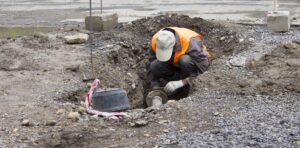World Water Day Part 2
More than two billion people across the globe don't have access to safe drinking water. World Water Day brings awareness to those clean water access issues. Read our two-part blog series today on how we must improve water infrastructure right here in the U.S.
This article was partially posted on May 5, 2021 and has been updated to reflect new investments in U.S. water infrastructure.
By Katie Harris, BlueGreen Alliance Legislative Director

Our nation’s drinking water, wastewater, and stormwater infrastructure is vital to the protection, treatment, and distribution of clean water. However, age, strain from population growth, lack of investment, the pervasiveness of lead pipes, and emerging threats from climate change have increased the burden on the current water infrastructure system and health risks to communities. The nation’s wastewater and drinking water infrastructure received grades of “C-” by the American Society of Civil Engineers (ASCE), respectively.
The great news is that the Biden administration has made historic and massive investments in our water infrastructure through the Bipartisan Infrastructure Law (BIL) and the Inflation Reduction Act to ensure access to clean, safe drinking water for millions of people in the United States. Water infrastructure investments will boost our economy, create and sustain thousands of jobs while ensuring communities have safe water and water systems resilient to climate change.
The Bipartisan Infrastructure Law
The BIL invests $55 billion in our water systems—the largest federal investment ever. The law provides a little over $15 billion to fund the replacement of lead service lines and other lead remediation activities. This funding is important to improving public health and addressing inequality. As many as 12.8 million homes around the country get their water through lead pipes and service lines. Lead is a toxic metal that harms the brain and nervous system, potentially having irreversible effects. Communities of color and lower-income communities often bear a disproportionate brunt of the hazards of lead water contamination. Eliminating lead exposure in our water systems can not only keep communities safe and healthy, but also create family-sustaining jobs and boost local economies across the country, particularly if members of the impacted communities themselves are hired to do this work.
The $15 billion for lead service line replacement in the BIL would result in the creation of 200,700 jobs over 10 years.
The aging state of our nation’s water infrastructure is also staggeringly wasteful and needs significant updates to be more efficient.. The Drinking Water and Clean State Revolving Funds (DWSRF/CWSRF) are the main sources of funding for states not only to update and maintain water infrastructure, but also to ensure that this infrastructure is resilient to climate change. The DWSRF and CWSRF received an infusion of funding in the BIL–$23.5 billion, split equally between the two programs. The bill also makes permanent the Buy America provision in the DWSRF.
The Inflation Reduction Act
The Inflation Reduction Act includes a number of provisions that will improve the energy efficiency of our nation’s buildings, including family housing, schools, and commercial buildings. The law also includes $1 billion in grant funding for energy and water efficiency in affordable housing. These investments in residential energy efficiency complement the historic investment made in the Weatherization Assistance Program and the Low-Income Home Energy Assistance Program in the BIL. These investments show that we can meet our clean energy deployment and climate goals while ensuring communities that have traditionally been left behind in our economy have access to clean air, clean water, and the opportunity for a middle-class job.
Previous Investments
In 2021, the Senate overwhelmingly passed the bipartisan Drinking Water and Wastewater Infrastructure Act (DWWIA). DWWIA makes substantial investments: it authorizes funds for remediating lead in drinking water; reauthorizes the Drinking Water and Clean SRFs; makes permanent the Buy America provision in the Drinking Water SRF; starts a pilot program at the U.S. Environmental Protection Agency (EPA) for low-income water assistance; and authorizes funding for rural and disadvantaged communities. The bill is a great start to a bipartisan infrastructure package, but more will be needed to close the investment gap, truly fix and improve our water infrastructure, and create good jobs. However, Congress should fund investments at- and beyond the levels in DWWIA and the American Jobs Plan. Congress should:
- Fund the Clean Water SRF at $80- $100 billion over 10 years and the Drinking Water SRF at $50- $100 billion over 10 years;
- Permanently extend Buy America provisions for the Drinking Water SRF;
- Provide $17.5 billion over 10 years in funding for the U.S. Department of Agriculture’s (USDA) Water and Waste Disposal Loan and Grant Program;
- Provide $45 billion over 10 years to the EPA for complete Lead Service Line (LSL) Replacement in all homes and child care centers;
- Invest $4.5 billion over 10 years in the cleanup of PFAS, dividing the investment to:
- Fund a grant program at $2.25 billion over 10 years to help affected community water systems pay for treatment technologies;
- Fund a grant program at $2.25 billion over 10 years to help publicly owned treatment works with implementation of a pretreatment standard; and
- Direct additional funding to low-income affordability programs for water and sewer services.
President Biden also created the Justice40 Initiative which targets 40% of investments to disadvantaged communities—an important distinction for water infrastructure. Maintenance and improvement of water infrastructure is increasingly difficult for communities to afford. As these costs are passed on to consumers, existing affordability problems are exacerbated for many communities and individuals across the country. Congress can also address this problem by targeting water infrastructure funding to the communities that need it most; especially low-income communities, communities of color, and deindustrialized communities.
For more on why updating our water infrastructure is so critical, read part one of our World Water Day series.